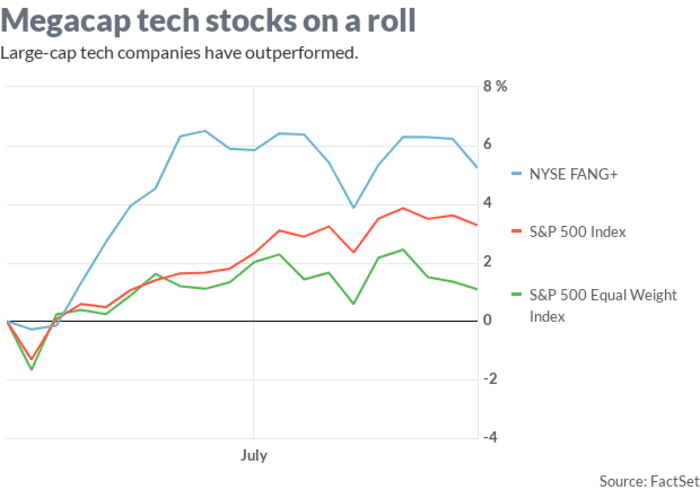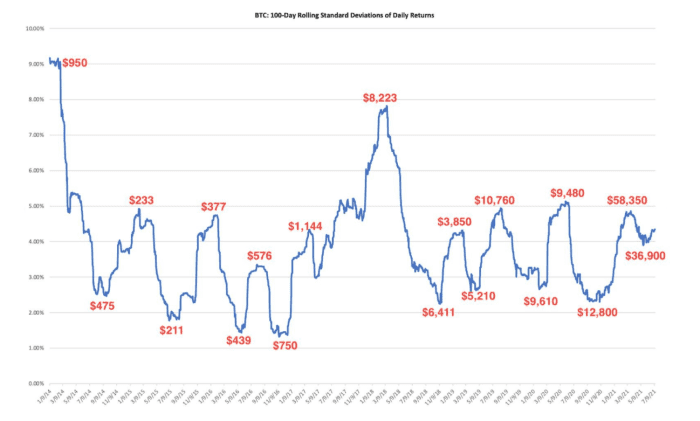This post was originally published on this site
The megacap technology stocks have been outperforming the broader market of late. The NYSE FANG+ index
NYFANG,
— which includes Facebook
FB,
Alphabet
GOOGL,
Amazon
AMZN,
and Apple
AAPL,
— has climbed 5% over the last month, compared with just 1% growth for the equal-weighted S&P 500
SP500EW,

Given the relief in bond yields, that makes intuitive sense. Tech stocks struggled when the yield on the 10-year Treasury
TMUBMUSD10Y,
rose as high as 1.75%, which by Thursday’s close had fallen down to 1.30%. The knee-jerk expectation in markets is that when interest rates rise, tech stocks fall, and vice versa.
There are two reasons why that relationship should hold. The first is simply that higher interest rates choke off economic growth, raising the cost of borrowing for consumers and businesses alike. The second is that, if a stock is the sum of its discounted future cash flows, then those flows are worth less, as the rate at which they are discounted increases. For growth stocks in the technology sector that are banking on future profits more than current ones, a higher discount rate is bad news.
The thing is, that relationship, while sounding logical, isn’t borne out by historical data. Andrew Berkin studied the relationship for a paper, “What Happens to Stocks when Interest Rates Rise.” Looking at 90 years of data, the S&P 500
SPX,
rose, on average, 10.8% when bond yields fell, and rose 12.2% when bond yields rose. Even separating out periods by quintiles when yields rose the most, the S&P 500 still gained 9%, on average. The relationship, or non-relationship as it were, also held outside the U.S., though it covered a shorter time period.
To Chadd Knights, a portfolio manager for Australia’s Duro Capital who cited the paper in an investment letter, rising rates shouldn’t really affect the investment process. According to Knights, Berkin also confirmed that growth stocks in particular aren’t negatively affected by higher interest rates.
“The reality is that most of us haven’t experienced sustained rising interest rates in the past. No one knows how people will react. And indeed, shares may fall on the back of a rising rate environment, even if the history suggests otherwise. But what this paper shows us is that that is not necessarily the case, which is what is to be construed if you read any of the popular financial news outlets,” Knights said.
Retail sales data on tap
Key data are on tap with the U.S. retail sales report for June, and shortly after the open, the University of Michigan’s consumer-sentiment report, with the latter also eyed for the reading on consumer inflation expectations.
Moderna
MRNA,
jumped 8% in premarket trade on the news the vaccine-making biotech will be included in the S&P 500.
Intel
INTC,
is in talks to buy GlobalFoundries from Mubadala Investment at a valuation of about $30 billion, according to The Wall Street Journal. A deal would boost Intel’s efforts to compete with Taiwan Semiconductor Manufacturing
TSM,
in making microchips for other companies.
Aluminum producer Alcoa
AA,
reported stronger-than-forecast earnings and boosted its shipment forecast.
Didi Global
DIDI,
may see pressure, after China sent regulators to the ride-hailing business, further escalating pressure on the company after its U.S. initial public offering.
Floods in Germany and Belgium have led to at least 100 deaths, authorities said on Friday.
The markets
U.S. stock futures
ES00,
NQ00,
edged higher ahead of the retail sales report. The yield on the 10-year Treasury
TMUBMUSD10Y,
also nudged higher, to 1.33%.
The chart

When is the best time to buy bitcoin
BTCUSD,
? According to DataTrek Research, when volatility is low. “Buying during periods of low volatility (between 2% and 3%, ideally towards the low end of that range) tends to yield positive future returns. The notable exceptions (September 2014, November 2018) came after especially large rallies (November 2013, December 2017) which took longer to burn off,” it said, referring to 100-day periods for volatility.
Random reads
A snake expert who said he was immune to venom turned out, alas, not to be.
Restoration work on a 16th century painting will wipe the smile off a vegetable seller.
Social-media platform Twitter
TWTR,
will now caption voice tweets automatically.
Need to Know starts early and is updated until the opening bell, but sign up here to get it delivered once to your email box. The emailed version will be sent out at about 7:30 a.m. Eastern.
Want more for the day ahead? Sign up for The Barron’s Daily, a morning briefing for investors, including exclusive commentary from Barron’s and MarketWatch writers.



